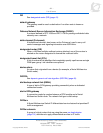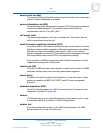
- 47 -
List of terms
Nortel Multiservice Switch 7400/15000/20000
Terminology
NN10600-005 7.2S1 Standard
PCR7.2 and up March 2006
Copyright © 2006, Nortel Nortel Confidential
egress accounting
A method of collecting information based on customer use of network
resources. The information is used by the service provider to develop billing
policies and quality of service parameters. As the name implies, this
information is collected at the exit (egress) points of the network for each
frame relay data link connection (DLC).
egress node
The last Nortel Multiservice Switch node that processes the packet as it
traverses the Multiservice Switch network; that is, the node from which the
packet exits the Multiservice Switch network.
See also ingress node (page 64) and tandem node (page 132).
egress protocol
The egress protocol synchronizes the accounting meters at the opposite ends
of the connection and facilitates the exchange of data collected by the
accounting meters.
egress traffic
Egress traffic refers to the traffic exiting from a Nortel Multiservice Switch
network through an access point.
EIR
See excess information rate (EIR) (page 50).
elastic connection
An ATM connection type that is able to respond to changes in bandwidth over
an ATM link through a decrease or an increase in its contracted data rate.
EM
See enterprise module (EM) (page 48).
emission priority (EP)
Traffic management mechanism used to handle delay requirements of
different types of traffic. Emission priority grading is implemented in three
emission queues, interrupting, high, and normal, which are serviced in that
order. The interrupting queue is typically used for CBR traffic, such as voice
and BTDS. The high and normal priority queues are used for VBR traffic, such
as frame relay. This queue arrangement allows delay-sensitive cells, such as
voice and video, to interrupt the transmission of long data frames, such as
frame relay. (In ATM FPs, there is no interrupting queue, since multiplexing is
already occurring at the cell level. The queues are known as high, medium,
and normal.)


















